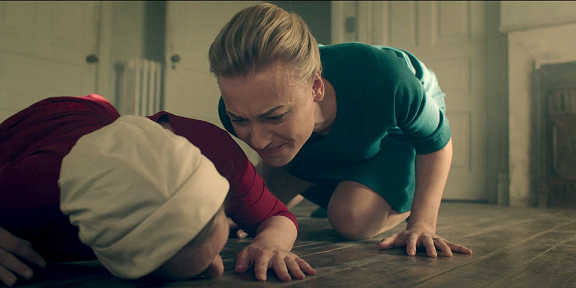Review: Hulu adaption of Atwood’s classic is a mixed bag
In 1985, Margaret Atwood envisioned a not so distant future where women are commodified by their fertility. Her critically acclaimed novel, “The Handmaid’s Tale,” told the story of Offred (Elizabeth Moss), a formerly middle-class working woman who had been delegated to the role of handmaid in Galied, a fundamentalist Christian nation. For Offred, this meant she was assigned to an upper-class couple who were unable to conceive. She was obligated to be inseminated by the husband and bear the couple’s children. The story was chillingly possible in 1985, however, in 2017 it is frighteningly plausible.
Hulu recently premiered their adaption of Atwood’s story with well deserved praise. This adaption is visually striking with captivating framing and focus. One becomes immersed in the nation of Gilead and quickly comes to understand the environment in which Offred is trapped. Horror and paranoia fill every interaction — Who can be trusted? Who is a spy? — but do not leave the viewer in despair. Offred’s humor and endurance keep spirits high, and ironic music choices will startle a laugh out of any viewer.
As in all dystopian stories, there is a resistance coalition. In “The Handmaid’s Tale,” they are called Mayday. Both the viewer and Offred become desperate to know more about the group, asking questions like: Can Mayday help? How many people are there involved in the resistance? What happens if they get caught? In the book, there was little time to answer all of these questions, leaving readers unsatisfied. With the serial nature of a Hulu Original, there will finally be more elaboration.
Though the visuals are striking and the story is captivating, I have my complaints. Some of the key symbols are stripped such as a needlepoint pillow that reads “Faith” in a society that has banned women from reading, and the “halo” on the ceiling — a vestige of the chandelier that the handmaid before Offred had hung herself from. In addition, there is more focus on the male characters than one would hope from a story about the objectification of women. Nick (Max Minghella), a character in the book with little more purpose than for Offred to project her sexual desires upon, has become a crucial player in her story. These paired with some conventional tropes of contemporary drama leave me with a sour taste in my mouth.
Some of these tropes include Bury Your Gays, in which a Queer character is killed — often in a graphic or gruesome manner — for the angst of a straight character, and the Black Best Friend, in which a black character is there to show that the protagonist is cosmopolitan, but the black character has no independent story, or even personality. Samira Wiley is fantastic as Moira — a lesbian and Offred’s best friend — don’t get me wrong, but Moira has thus far been supporting to Offred, not independent of her. Perhaps she will be expanded upon, and thus overcome this trope. However, I am not hopeful. For example, the handling of Ofglen (Alexis Bledel), the handmaid assigned as Offred’s companion, aligns with Bury Your Gays trope in that we see an unnamed lesbian graphically executed for the pain of her girlfriend, Ofglen, who, after performing an — in all truth — invigorating act of subversion, is captured by the police of Gilead and is presumed dead. All of her suffering, and the suffering of her lover, are for Offred’s inspiration. If that trope was so fully realized, Moira likely doesn’t stand a chance.
Something of note in this adaption is the shift critique in feminist discourse. In 1985, Atwood’s novel made a parallel to the feminism of her contemporaries truncating free speech in the form of an in story book burning targeting pornography, and in Gilead’s arguing that taking freedom away from women makes women safe from male sexual deviance.
These comment on the notion of women as the arbiters of sexual violence.
Yet in our contemporary version, the critiques are focused on pseudo feminist rhetoric such as empowerment through the conscientious choice to abdicate one’s own independence, and that one woman may need to stand on the neck of another in order to reach her goal.
A direct focus on “White” feminism.
Complacency abounds in both versions pulling the stories together with one crucial moral: Don’t be a passive player in your own future.
However, the most egregious mistake made in this adaption is in how the issue of fertility is framed. In the novel, fertility is a lesser issue to the hypocrisy of theocratic ideology. In this adaption, it is center stage. Serena Joy (Yvonne Strahovski) is one such warped aspect. Serena Joy was a televangelist who encouraged women to return to being housebound. She was a bitter and cruel older woman whose purpose was to show how even female Gilead supporters could still be unhappy with their new reality. In the Hulu adaption, Serena Joy is a moderately attractive woman in a loveless relationship that we, the viewers, are supposed to pity. However, the Hulu viewers are not supposed to pity Serena Joy because she was mistaken and is now remorseful. No, apparently we are to pity her because she spent so long trying to have a baby. The Hulu audience view her marriage as having collapsed because she did not have a baby. A prevailing attitude is that Handmaids only have to exist until there are enough babies. Women being seen as walking uteruses is back burner to the fact that all these people cannot have babies. Babies babies babies.
In the end, Atwood’s biggest critique was at western society’s lingering belief that a woman has failed to fulfill her purpose in life unless she has a kid on her hip.
And my biggest critique is that this show missed that point by a mile.
I do not care if Serena Joy loves her husband and has tried for years to conceive.
I do not care if declining birthrates damn the species.
I do not care about any of the reasons Gilead was formed.
I care about freedom and reality.
That is why I think the show is visually and psychologically relevant, but socially stagnant







